The Samsung Galaxy S6 and S6 edge Review
by Joshua Ho on April 17, 2015 9:00 AM EST- Posted in
- Smartphones
- Samsung
- Mobile
- Galaxy S6
- Galaxy S6 Edge
System Performance
In order to test the Exynos 7420 and the phone in general, we turn to our suite of benchmarks which are able to show how the device performs in common general computing workloads. Something as simple as web browsing is still surprisingly intensive on mobile phones, and in general Android can often be quite stressful to run in the constraints of a ~3W total TDP especially on any phone still running Dalvik due to its strong reliance on bytecode and a virtual machine that translates bytecode to machine code just before and during application runtime. ART improves this significantly, but is limited in the nature of optimization as AOT compilation optimizations are limited by the CPU power of the SoC and the need to compile the application in a reasonable amount of time.
As always, we'll start things off with our browser benchmarks. After getting to use the phone, it became clear to me that Chrome is poorly optimized against the Galaxy S6 as Samsung’s browser is clearly superior in performance. For that reason I've gone ahead and run our benchmarks on both Chrome and on the stock browser, as seen below.

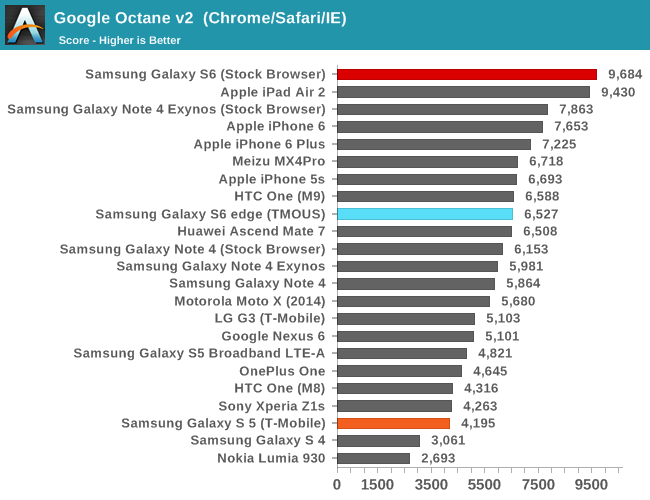

Needless to say, in order to see the full potential of the Exynos 7420 and its cluster of A57s, it’s necessary to use Samsung’s stock browser. This performance is really quite amazing when compared to Apple’s A8X, which has basically been the gold standard for performance in the mobile space in the context of ARM SoCs.
Moving on, as a part of our updates to the benchmark suite for 2015, we'll take a look at Basemark OS II 2.0, which should give a better picture of CPU performance in addition to overall device performance.
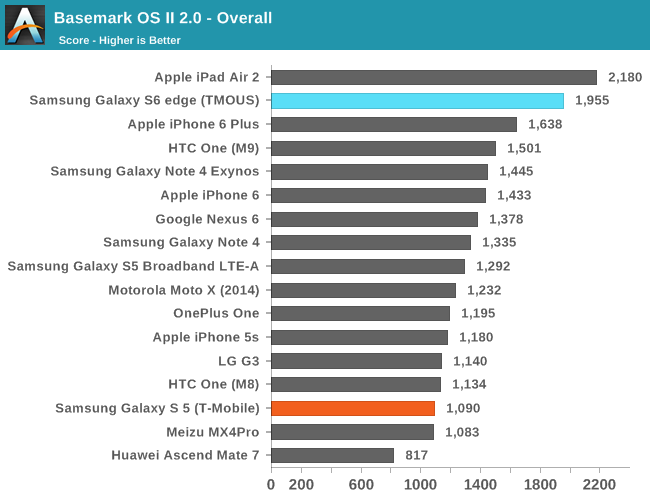
The browser benchmarks seem to hide some pretty enormous variability as the Galaxy S 6 edge (which is comparable to the Galaxy S 6) sets a new record among Android devices. The only challenger is the iPad Air 2, which uses the A8X SoC with three Enhanced Cyclone cores and the semi-custom GXA6850 GPU.
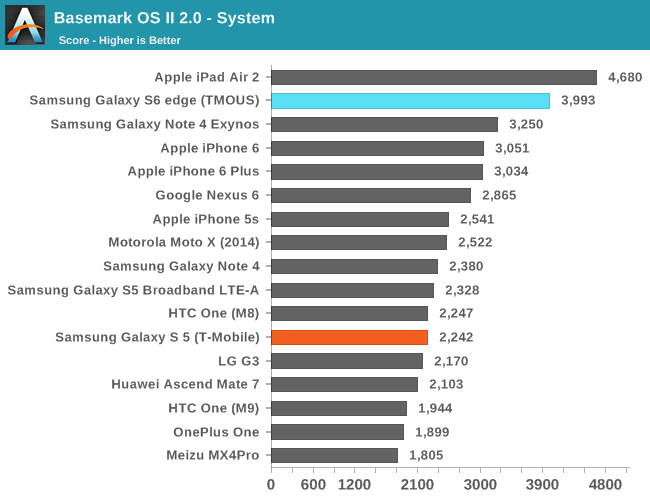
This system test contains a floating point and integer test, in addition XML parsing, which means that this test mostly stresses CPU and RAM. Interestingly enough, the Exynos 7420 pulls far ahead of both the Exynos 5433 and Snapdragon 810 in this test, and approaches the A8X. The difference between the 5433 and 7420 is likely a combination of the higher clocks on both the A57 and A53 clusters for the 7420 (1.9/1.3 on the 5433, 2.1/1.5 on the 7420), in addition to the ability to stay at a high 'overdrive' clock due to reduced leakage from the 14LPE process. The One M9 likely falls a bit short here due to HTC's governor settings restricting the use of all 8 cores simultaneously.

While one might guess that the memory test of 'Basemark OS II 2.0 - Memory' is of RAM, this is actually a test of the internal storage. Once again we see the S6 edge come close to leading the pack due to the use of the new UFS (Universal Flash Storage) standard. Casual examination reveals that the S6 edge has a queue depth of 16, and that it identifies itself with the rather cryptic model name of KLUBG4G1BD-E0B1.
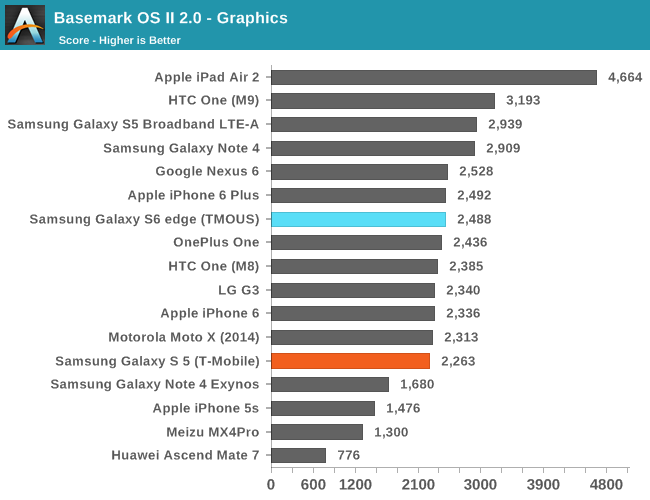
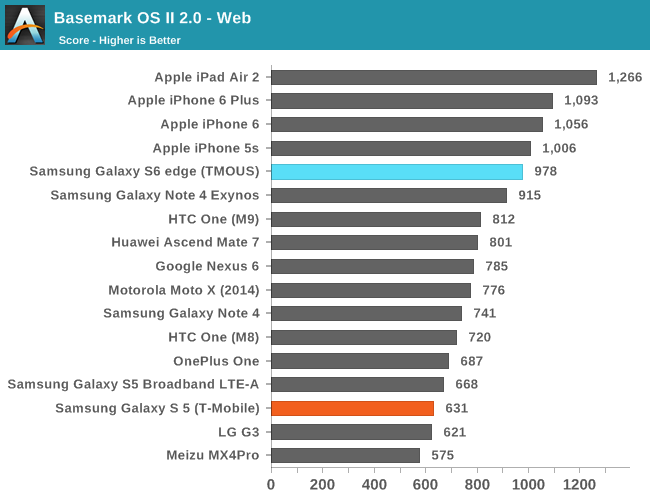
For the web test, it uses the built-in WebView rendering engine rather than Chrome and paints a distinctly different picture, especially because these tests are focused on HTML5 and CSS rather than JavaScript. Here we can see that the iPhone 6 and iPad Air 2 continue to hold their lead, but the Galaxy S6 is pretty much the king of the hill when it comes to Android devices.
Our next system benchmark is PCMark, which does a number of basic benchmarks designed to stress various aspects of the device in everyday workloads like video playback, web browsing, text editing, and photo editing. This tends to test every aspect of a mobile device, unlike microbenchmarks that can often miss aspects of the system that can affect performance.
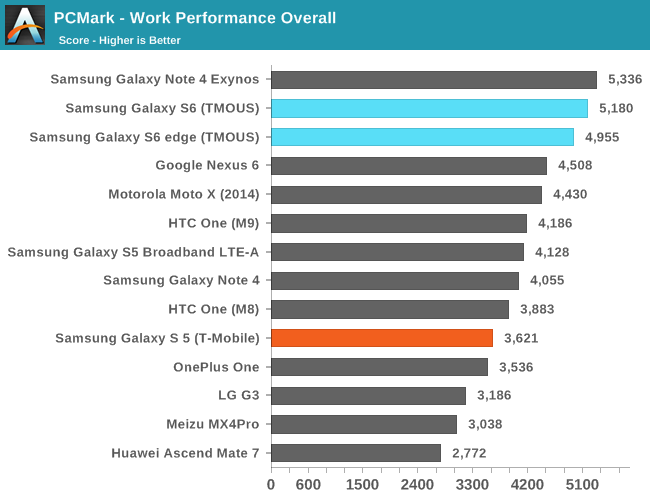
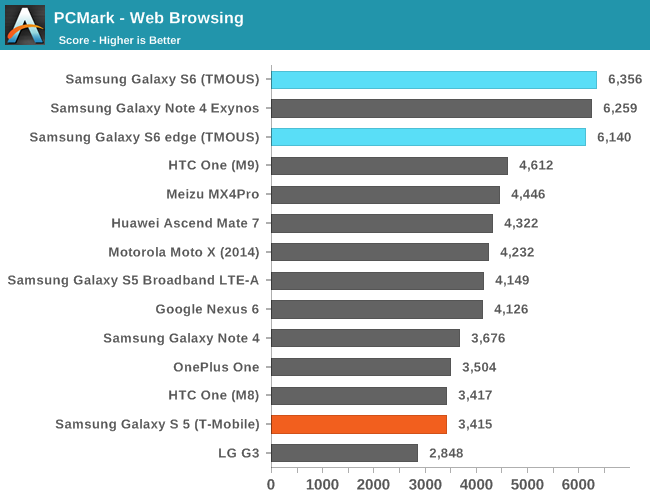
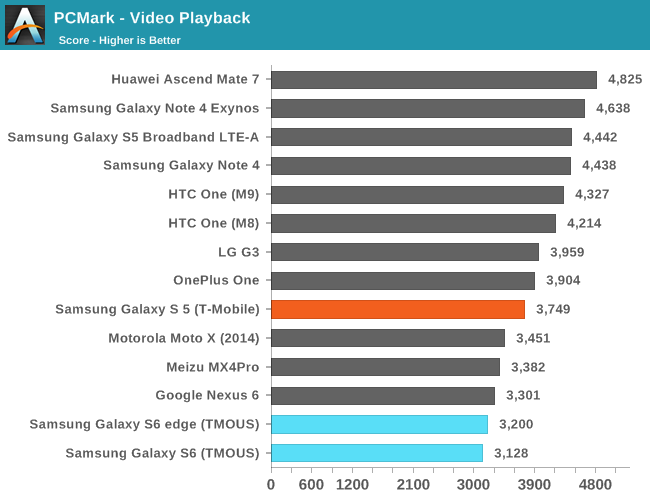
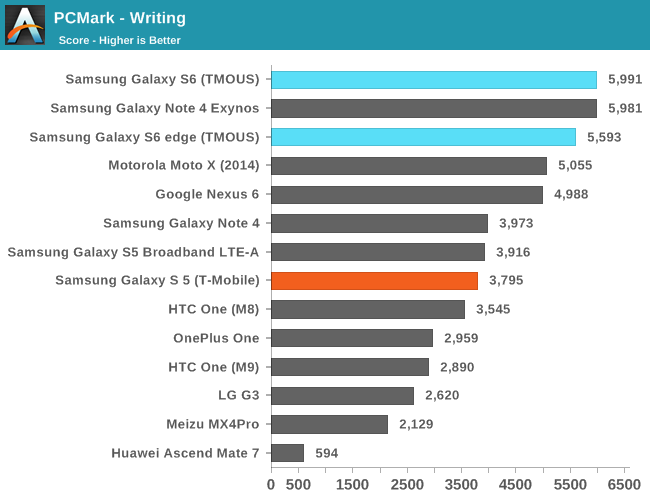

In these tests, the Galaxy S6 continues to perform strongly here due to the fast NAND storage solution and the Exynos 7420 SoC. As we have already covered the Basemark OS II 2.0 results in previous articles, I would refer back to it as those scores are final and have already been contextualized.
Overall, in these general purpose computing tasks that stress CPU, memory, and NAND performance we can see that the Exynos 7420 is off to a flying start. Samsung Mobile should focus more strongly on optimizing the software stack against Chrome as mobile Chrome has around twice the user share of stock Android browsers. I often say that the SoC is the foundation to a good smartphone, and in the case of the Galaxy S6 it feels like this is especially true.










306 Comments
View All Comments
FlushedBubblyJock - Friday, April 24, 2015 - link
who are you kidding, yourselves ?YEARS AGO our big gov sucked all your data, and has been ever since
retroactive and completely illegal pardons were then issued
Frankly I'd rather he laws and the reality be that the idiot criminal government never be able to get anything, and the fact that they are sucking down everything all the time means I can't wait for it to stop
It's a principle, not a crime, sheep
They have no right to anything, EVER, that's what law abiding citizens DEMAND.
yvn - Friday, April 17, 2015 - link
I compared the edge to my iPhone 6 plus display and find still the display of the edge is still too saturated even in basic mode, how so...according to the benchmarks the display should be as good as the 6 plus but it was not, the color accuracy is still not as accurate??FlamingDragon810 - Friday, April 17, 2015 - link
Maybe because you're so used to the washed-out colors on your iPhone 6?The S6 has the most color-accurate display on the market. It's far better than the cheap IPS display on the iPhone 6.
yvn - Friday, April 17, 2015 - link
it is not true, my iPhone 6 plus display matches spot on with my calibrated iMac 27" screen via Spider 4 and Color Eyes Display Pro....so no Sir you are the one that is used to oversaturated colors on Samsung phones.....I am a full time photographer so I know a thing or two about accurate colorsFlamingDragon810 - Friday, April 17, 2015 - link
http://www.extremetech.com/mobile/200868-displayma...You're a full-time photographer who is used to washed-out colors from Apple.
Peichen - Saturday, April 18, 2015 - link
Ignore the troll. Both S6 and 6+ screen are accurate but S6 have lower white point than 6+. I am not sure about the color mode and adaptive color setting on the phone. I would suggest you wait for Erica Griffin's full review to come out on YouTube as she review color mode in detail. She only have hands-on review at the moment.generalako - Saturday, April 18, 2015 - link
You clearly don't know what the hell you are talking about. Read this review of the screen of the S6 by Displaymate (the only actual and legitimate display-tester out there): http://www.displaymate.com/Galaxy_S6_ShootOut_1.ht...The Galaxy S6 (like the Note 4) has by far the best display out there.
" The measured Absolute Color Error for the Galaxy S6 Basic Screen Mode is just 1.6 JNCD, tied with the Galaxy Note 4 as the most color accurate display that we have ever measured for a Smartphone or Tablet, which is visually indistinguishable from perfect, and is very likely considerably better than your living room TV or any display that you own.
assasinezio34 - Friday, April 17, 2015 - link
i have sold my s6 after 7 painful day.i really loved this phone.camera,screen exc..but battery life drove me crazy.returned to my iphone6 plus.Margalus - Friday, April 17, 2015 - link
I have never owned an apple product, and thought I never would. But after my experiences with the s4 and the android os things might be different next time. I still don't like apple and don't really want an iphone. I am a very light user, it's mostly for phone calls. What good is a phone that on it's best day will last about 16 hours. Then on other days with occasional bugs that cause the OS to go crazy and use the battery up in 4-5 hours with no usage..UrQuan3 - Friday, April 17, 2015 - link
Overall excellent review. I still really appreciate the screen color and gamut testing. It sets Anandtech apart. What equipment are you looking for to do audio testing? In my case, I am more interested in the headphone output than the speakers as I can't use the speakers in public anyway.